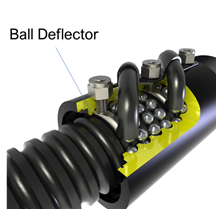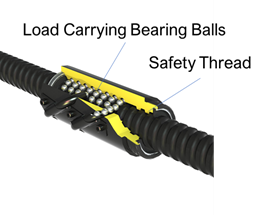Designing Safer Ball Screw Assemblies
Ball screws provide several unique benefits when compared to other standards, such as roller screws or acme screws. Just a few of these include:
- High Efficiency: Ball screws typically operate at a minimum of 90% efficiency. This makes them an optimal choice in converting rotary motion into precision linear motion.
- Load Capabilities: Ball screws are highly versatile in so many industries and applications because they can carry remarkably heavy loads at fast, efficient speeds.
- Cost-Effectiveness: In the long run, ball screw systems are a more cost-effective alternative to pneumatic or hydraulic systems, which require constant power, hoses, fluids, etc...
However, there are some very important safety factors to consider when designing a given ball screw assembly for your applications. These factors can also provide longer life and more reliable performance. There are several factors conducive premature ball nut failure, such as misalignment, impact loading, a lack of lubrication, contamination, or external damage to the return circuits. However, the primary failure mode for ball nuts is fatigue of the bearing balls or thread surface.
Premature failure may result in the loss of some or all of the balls between the nut and screw. When all the balls are lost, the nut is no longer engaged with the screw and therefore may not move when the screw is rotated or, in vertical applications, will free fall along the screw. Let's look at some of the typical failure modes below.
Typical premature failure modes
- Misalignment of the ball nut to the screw can result in undesired side loading or eccentric loading. Both of these will reduce life. Additionally, this may cause the ball bearings to split or get flats on them. Additionally, the ball bearings may even break out of the return tubes.
- Metal chips, dirt or debris in the ball nut may impede the call bearings from free circulation. The ball bearings may get flats on them because of skidding,
- Lack of lubrication. Proper lubrication will help to dissipate heat and reduce metal-to-metal wear of components.
- Exceeding the ball nut critical speed can break pickup fingers off, causing the balls to come out of the nut. Exceeding the screw critical speed will also cause the whip resulting in misalignment.
In some applications, this loss of ball type failure could result in injury or even death. Therefore, this failure needs to be considered in the design to assure proper safety.
Possible preventative measures include
- Using two or more screws supporting the load.
- Nuts with multiple independent ball re-circulation circuits.
- Ball deflectors which prevent the balls from exiting the ball nut out the ends.
- Using industry-leading integral safety thread ball nuts.

The integral safety thread is a unique solution that provides the ball nut with a secondary safety thread (a reverse thread in the nut body itself). This special thread extends from the ID of the nut to below the OD of the screw without making contact. In the unlikely event that all the balls in the nut are lost, this safety thread will engage the screw and prevent free fall.
Although this thread can be used to lower the load to a safe position, it is should not be used otherwise. This can also be accomplished with the use of a special flange if the ball nut body cannot accommodate the safety thread feature.

Nook ball screw design are the safest in the marketplace. All manufacturing operations are tightly controlled in one facility using demanding standards.
Quick Reference
| Screw | Helix | Safety Thread | Ball Deflector |
| 0631-0200 | RH | SBN10583 | - |
| 1500-0500 | RH | SBN10974 | - |
| 2250-0500 | RH | SBN10629 | SBN10074 |
| 2250-0500 | LH | - | SBN10075 |
| 2250-1000 | RH | - | SBN10260 |
| 3000-0660 | RH | SBN10202 | SBN10202 |
| 3000-0660 | LH | - | SBN10257 |
| 3000-1500 | RH | - | SBN4986 |
| 4000-1000 | RH | SBN3258 | SBN3258 |

